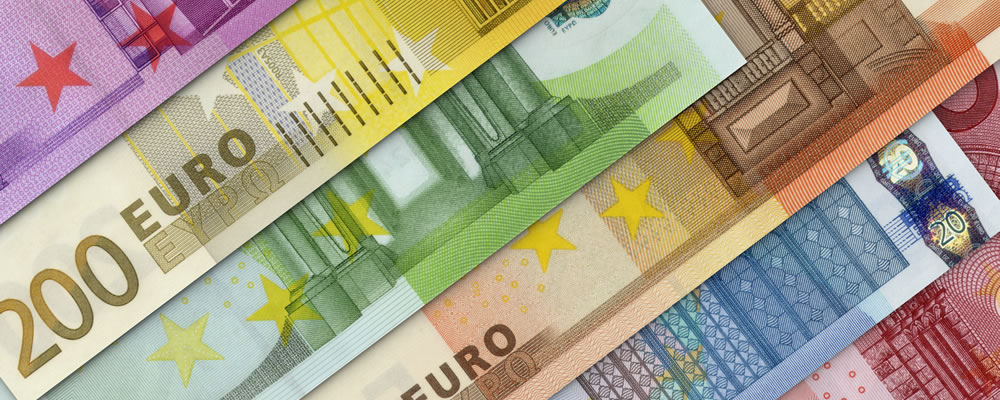Although markets continue to speculate that the European Central Bank will extend its quantitative easing program before the end of the year Euro exchange rates have remained on a modest uptrend.
- Euro exchange rates buoyed by Deutsche Bank profit – Worries over banking sector eased somewhat
- Pound failed to benefit from stronger-than-expected UK GDP – Investors wary as growth remained driven solely by service sector
- EUR USD exchange rate on stronger footing thanks to mixed US data – Markets reluctant to price in higher odds of 2016 Fed rate hike
- Strong US GDP forecast to weigh on EUR USD exchange rate – Prospect of greater monetary policy divergence expected to rise
Euro Exchange Rates Benefitted from Weakness of Dollar, Pound
Confidence in the US Dollar was weakened by an unexpected contraction in durable goods orders for September, something that does not suggest particular robustness for the world’s largest economy. As a result the EUR USD exchange rate continued to trend higher in the region of 1.09.
Demand for the Pound diminished further as worries over the future of the UK economy persisted. With the government’s Brexit strategy still far from clear the bias for Sterling remains to the downside. This saw the EUR GBP exchange rate extending its gains towards the close of Thursday’s European session, trending around 0.89.
(Previously updated at 12:23 21/10/16)
Despite a stronger showing from the first post-referendum UK GDP the EUR GBP exchange rate has continued to make gains.
Euro (EUR) Exchange Rate Volatility Forecast on German Inflation Data
There was some disappointment for the Euro (EUR) on Thursday morning when the Eurozone M3 money supply for September was found to have dipped unexpectedly. A weakening in the money supply suggests that inflationary pressure within the currency union could be faltering again, a prospect that will not encourage the European Central Bank (ECB). However, as Deutsche Bank posted a surprise profit on the quarter the appeal of the single currency remained heightened.
Confidence in EUR exchange rates could be boosted further ahead of the weekend if the latest German Consumer Price Index report indicates a continued uptick in domestic inflation. Signs of strength from the Eurozone’s powerhouse economy should encourage investors to continue favouring the Euro over its rivals, although concerns remain over the robustness of other member states. Even a strong showing here is unlikely to dismiss the likelihood of further ECB easing, though, as Tim Riddell, research analyst at Westpac, notes:
‘Oct CPI and initial Q3 GDP may show considerable headwinds and underscore the need to maintain ECB’s accommodation. The EU has also issued warnings to errant Eurozone states over their inability to adhere to budget commitments. The lack of any loosening of budgetary constraints highlights ECB’s monetary policy as the only feasible tool to support Eurozone growth.’
EUR GBP Exchange Rate Trends Higher Despite Stronger-than-Forecast UK GDP
Investors were surprised to find that the UK third quarter GDP had bettered expectations on both the year and the quarter, showing a much more modest slowdown than forecast to dip from 0.7% to 0.5%. This offered some encouragement in the resilience of the domestic economy, boosting the Pound (GBP). However, the initial weakening of the Euro Pound (EUR GBP) exchange rate was soon reversed as the details of the report revealed that growth was entirely dependent on the service sector in the last quarter. With economists still warning that the impacts of the Brexit vote are likely to be felt over the longer term the bias for the Pound remains to the downside.
Brexit-based anxiety could continue to drag on the Pound in coming days, with no fresh domestic data set for release until next week. Should the rhetoric of politicians continue to indicate that a hard Brexit is more likely the EUR GBP exchange rate is expected to benefit.
US Dollar (USD) Trends Narrowly with High Odds of 2016 Fed Hike Already Priced In
Better-than-expected US PMIs failed to offer particular encouragement to the US Dollar (USD), meanwhile, as the appeal of the safe-haven currency remained limited by increased risk appetite. The impression of strength within the world’s largest economy was also undermined by a larger-than-expected increase in wholesale inventories, something which points towards faltering consumer demand. With the picture of the US economy remaining generally mixed and markets having already priced in relatively high odds of a December interest rate hike from the Federal Reserve the Euro US Dollar (EUR USD) exchange rate remained on a stronger footing.
Greater support for the ‘Greenback’ could come on Thursday afternoon, however, if September’s durable goods orders data proves positive. If consumer optimism is indicated to have remained strong then the EUR USD exchange rate may struggle to hold onto its gains, particularly ahead of the third quarter US GDP report. With bullish data likely to encourage the Fed to deliver a rate hike before the end of the year this could see the US Dollar pushed higher.
Current Interbank Exchange Rates
At the time of writing, the Euro US Dollar (EUR USD) exchange rate was trending narrowly around 1.09, while the Euro Pound (EUR GBP) pairing was trending higher at 0.89.



